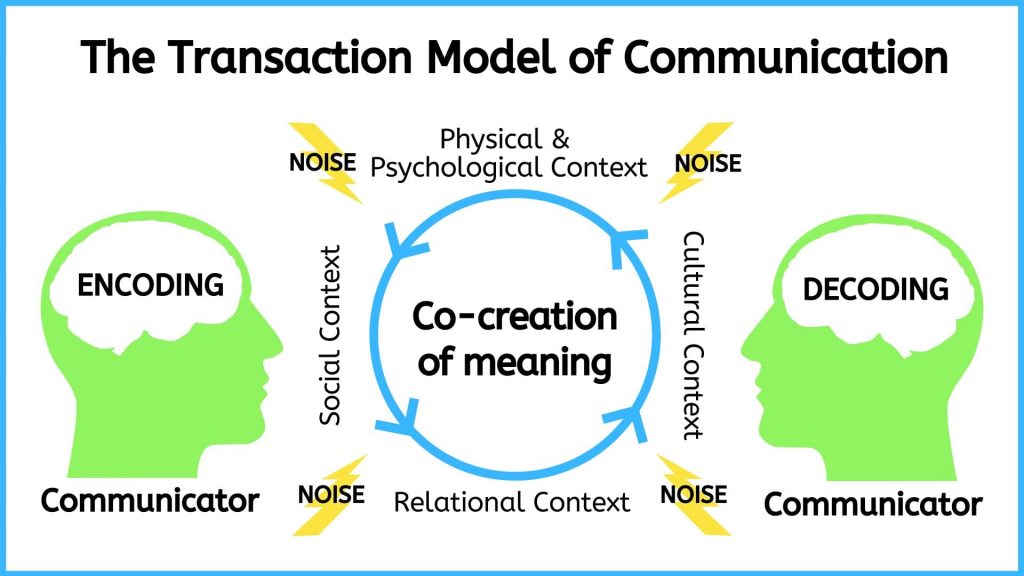Transaction Model of Communication
The Transaction Model of communication (see Figure below) differs from the Transmission and Interaction Models in important ways, including the conceptualization of communication, the role of sender and receiver, and the role of context (Barnlund, 1970).
The Transaction Model of communication describes communication as a process in which communicators generate social realities within social, relational, and cultural contexts. In this model, MRTs don’t just communicate to exchange messages; they communicate to:
- Create relationships.
- Form intercultural alliances.
- Shape self-concept.
- Engage with others in dialogue to create communities.
In short, you don’t communicate about your realities; communication helps to construct your realities.
The roles of sender and receiver in the Transaction Model of communication differ significantly from those in the other models. Instead of labeling participants as senders and receivers, the people in a communication encounter are referred to as communicators. Unlike the Interaction Model, which suggests that participants alternate positions as sender and receiver, the Transaction Model suggests that you are simultaneously a sender and receiver.
For example, when you first meet a patient, you send verbal messages saying hello, who you are, and why you are there. Before you are done your introduction, the patient is reacting non-verbally. You don’t wait until you are done sending your verbal message to start receiving and decoding the nonverbal messages of the client. Instead, you are simultaneously sending your verbal message and receiving the client’s non-verbal messages. This is an important component of this model because it helps you understand how you can adapt your communication. For example, in the middle of sending a verbal message, you can adapt your communication in response to the non-verbal message you are simultaneously receiving from your communication partner.

Figure: The Transaction Model of Communication
The Transaction Model also includes a more complete understanding of context. The Interaction Model portrays context as physical and psychological influences that enhance or impede communication. While these influences are important, the model focuses on message transmission and reception. Because the Transaction Model of communication frames communication as a force that shapes your realities before and after specific interactions occur, it must account for contextual influences outside of a single interaction. To do this, the Transaction Model considers how social, relational, and cultural contexts frame and influence communication encounters.
Here is a short description of each context:
- Social context refers to the stated rules or unstated norms that guide communication. As you are socialized into the MRT profession, you learn rules and norms for communicating, which are often referred to as communication strategies and principles. Some common rules that influence social contexts in medical radiation technology include being truthful during your conversations, being patient and encouraging the patient to speak, demonstrating empathy, speaking clearly, making eye contact, and so on.
- Relational context includes the previous interpersonal history and type of relationship you have with a person. You communicate differently with someone you just met versus someone you’ve known for a long time. Initial interactions with people tend to be more highly scripted and governed by established norms and rules. As an MRT, you should always engage in communication in a professional manner because the MRT-patient relationship is a professional one, not a personal one.
- Cultural context includes various aspects of identity such as gender, ethnicity, sexual orientation, class, and ability. While you may be able to identify some aspects of the cultural context within a communication encounter, there may also be cultural influences that you can’t see. A competent communicator shouldn’t assume they know all the cultural contexts a person brings to an encounter, because not all cultural identities are visible. Some people, especially those with identities that have been historically marginalized, are highly aware that their cultural identities influence their communication and influence how others communicate with them. Conversely, people with identities that are dominant or in the majority may rarely, if ever, think about the role their cultural identities play in their communication.
You need skills to adapt to shifting contexts, and the best way to develop these skills is through practise and reflection.
Attribution Statement
Remixed with original content and adapted, with editorial changes, from:
Communication in the Real World: An Introduction to Communication Studies by University of Minnesota. Licensed under a Creative Commons Attribution-NonCommercial-ShareAlike 4.0 International License, except where otherwise noted.

